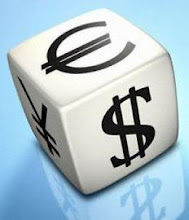1) Make the logical conclusion that more money means cheaper money, i.e. you sell USD, because E/U just made new highs and the trend shall continue.
2) Let E/U retrace to pre-announcement levels, buy it, quickly scalp 15 pips and be done for the day.
3) Sell E/U at the highs with a tight stop, knowing everything bounces.
4) Don't do anything, go eat breakfast and come back when the market calms down.
Here's the one-hour chart.

E/U sold off 200 pips after the announcement. First, people who were short got killed on the initial spike up. Then, people who went long got killed during the drop.
Usual market behavior? Probably not.
Surprising market behavior? Probably not.
Untradeable market behavior? Probably not.
The reality of trading? Yes.
After seeing the spike, I initially went short, then long after the retracement. I got out for +10 each time. Then E/U just got stuck and refused to go higher? Sign of something fishy going on there? I look at U/CHF moving higher, U/CAD moving higher and even U/J moving higher. I short E/U, boom drops immediately. I get out for +15 and call it a day. E/U then drops another 150 pips throughout the day, but I don't really care. It might as well have continued higher.
I talked about the divergence on E/U on Thursday, but I also said I wasn't going to short it right away. It was a good decision wasn't it? I waited for a move up, then shorted and got out very quickly. No need to have an open position during the day and stress about it at work. 20 pips = 2% for me, do it every day and you're up 40-45% a month.
One more thing. I did trade E/U on Friday, but not just E/U. Everyone is trading E/U now and the more people trade, the more volatility you'll see. I traded U/CHF and U/CAD as well, which moved less but certainly with less volatility. By trading instrument not everyone is talking about at the moment, you can go "under the radar", hence avoid the volatility. People say only n00bs trade E/U. Well, let me rephrase. N00bs who lose usually trade E/U :)
Now enough of this, let's look at what you could have done during the day. E/U first came to 1.4000, bounced 20+ pips, then bounced 40+ pips (however, I wouldn't have traded the second bounce up for sure), then bounced off the red moving average. Beautiful.

U/J had a textbook bounce off the hourly low. I don't trade U/J, but seeing this tells you one thing - someone wants to buy a lot of greenbacks!

Here's E/J, first look at the hourly chart. First, the trendline was broken and the blue line would have been your buy.

On M15 you see that we bounced 20+ pips up, exactly to the trendline, then continued the down move.

That's it, have a great weekend :)
Tyler









